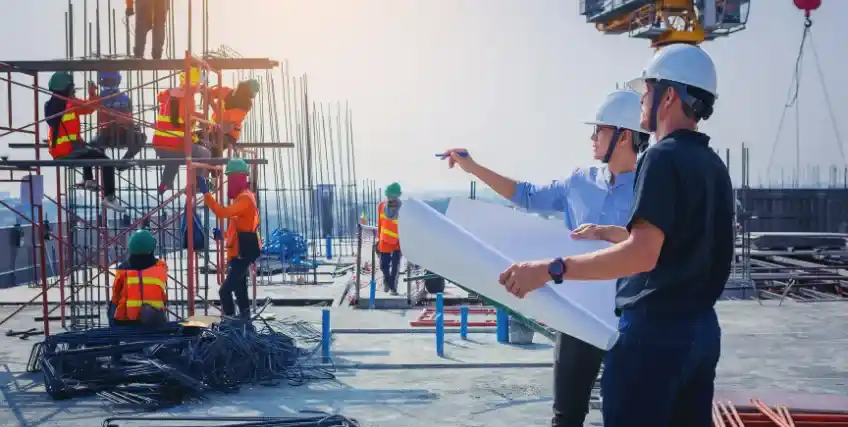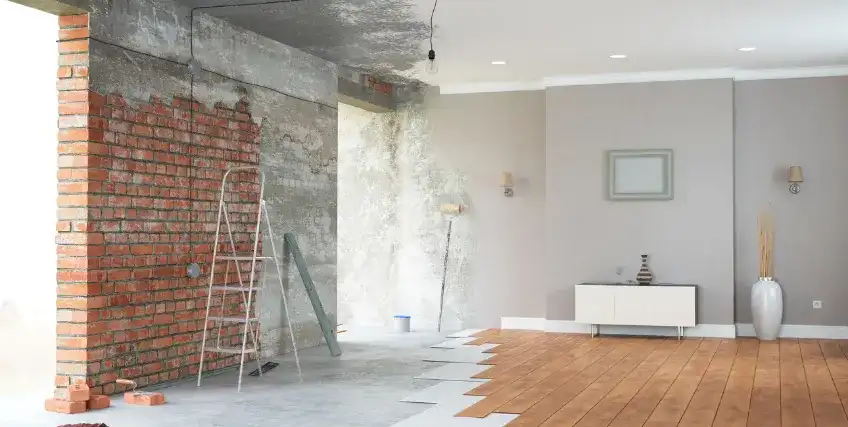Navigating the Challenges of 0% Down Construction Loans: What Borrowers Should Know
October 16, 2025 | Last Updated on: October 16, 2025

For many borrowers, a 0% down construction loan sounds like a dream come true. The ability to finance the construction of a new home or business without a hefty upfront payment is appealing, especially in an economy where saving for years for a large down payment feels increasingly out of reach.
While the concept of a zero down construction loan might seem simple, though, the reality is much more complex. That’s because true no-down-payment construction loans are rare to find, highly regulated, and come with some specific challenges that borrowers need to understand before ever signing on a dotted line.
Read on to learn more about the opportunities and risks of a 0% down construction loan, who might be able to qualify, and how to prepare if you’re hoping to build without coughing up a large investment upfront and out-of-pocket.
Understanding Zero Down Construction Loans
A 0% down construction loan is a special type of financing that covers the entire cost of building a home from the ground up, without requiring the borrower to make an initial down payment or cover any of the expenses out of their own pocket. Unlike a traditional mortgage loan product, a zero-down lender agrees to front the entire project cost, assuming more of the project’s risk.
For most lenders, construction loans are considered higher-risk than other types of home loans, simply because the property securing that debt doesn’t yet exist. For that reason, down payments on construction loans typically range from about 10% to 30%, though this varies by lender, project specifications, and buyer eligibility.
While they do exist, finding a construction loan with 0% down can be rare. However, there are limited programs, such as VA-backed loans or rural development loans, that may allow qualified borrowers to move forward with building their dream home without putting any money down.
Can You Really Get a Zero Down New Construction Loan?
Breaking ground on a brand new home without contributing a penny to the initial construction phase… It sounds too good to be true! So, you might be asking: Can I actually, really and truly get a home construction loan without putting a penny toward a down payment?
The short answer is yes, but only under specific circumstances. And only for borrowers who meet pretty strict underwriting criteria for certain loan types.
The most common type of zero down construction loan available today is the 0% down VA construction loan. This loan is offered by a number of VA partner lenders and is intended for eligible veterans, active-duty service members, and certain surviving spouses. After loan approval, it allows qualified borrowers to finance the full cost of both their land purchase and subsequent construction without contributing any down payment. Provided they meet VA lending criteria and work with an approved builder, these borrowers will also enjoy competitive interest rates and more flexible minimum credit score requirements than conventional mortgage loans.
Outside of VA programs, a true zero down construction loan option is much harder to find. Some USDA construction-to-permanent loans offer similar benefits in designated rural areas, but strict geographic and income limitations apply. For most borrowers, lenders still expect buyers to put up some form of equity, whether that comes from existing land ownership, savings, or builder concessions.
Why Zero Down Construction Loans Are Hard to Find
Lenders take on a lot of risk when lending money to for a home purchase, but at least that debt is secured by collateral: typically, the property in question. With construction financing, though, there isn’t a home built yet, so this type of loan is inherently riskier to lenders than a standard conventional loan. Zero down construction loans increase that risk even further, leaving the lender with full exposure if the borrower defaults or if construction costs spiral out of control.
For that reason, lenders typically impose special safeguards for construction loans, particularly those with zero- or low-down payment options. These often include higher credit score requirements and verified income limits, which may help weed out ineligible borrowers as part of the pre-approval process.
Lenders usually want to see detailed construction plans and appraisals based on the expected value of the completed home before approving one of these loans, too.
Government-Backed Options for Zero Down Construction Loans
Borrowers won’t usually find conventional lenders offering a 0% down construction loan. However, several government-backed programs can make it possible to build a single-family home with little or no upfront cash. The three most common routes are through VA, USDA, and FHA construction loans. Each one has its own unique eligibility rules, benefits, and challenges to note.
VA Construction Loans
Backed by the Department of Veterans Affairs (VA) and offered through qualified lenders, the VA loan is a great option for both repeat and first-time buyers who are qualified veterans, active-duty service members, and certain surviving spouses. And within this program, the 0 down construction loan remains the most accessible path to financing a new home with no down payment.
With a VA-backed zero down construction loan, borrowers typically enjoy competitive interest rates, lower closing costs, and no private mortgage insurance (PMI) requirement, all of which can lower mortgage payments. The Veterans Affairs guarantees a portion of the loan, reducing the lender’s risk and allowing borrowers to finance both land and construction at more competitive terms than offered with many conventional loans. These VA one-time close loans also streamline the process, so you don’t have to get a separate construction loan that you refinance into a fixed-rate mortgage at the end.
However, strict conditions apply if you go this route: the builder must be VA-approved, the home must meet VA appraisal standards, and the VA loan applicant must plan to occupy the property as a primary residence once construction is complete.
While the VA program offers a true construction loan with 0 down, it’s relatively underused due to a limited lender pool and the complexity of VA construction financing.
USDA Construction-to-Permanent Loans
The U.S. Department of Agriculture’s (USDA) Single-Close Construction-to-Permanent Loan Program also backs zero down construction loans in specific rural areas. These loans are designed to promote homeownership in low-to-moderate-income communities and can cover both the construction and permanent financing phases with a single closing. Like VA programs, USDA loans allow for 100% loan-to-value (LTV) financing, with zero down required.
If approved, you’ll can make only interest payments during the construction period. Since the USDA fully backs the loan, it’s lower-risk to lenders than other construction loan options. The funds can also be used to cover expenses other than construction, like landscaping, inspection fees, and even setting aside funds for contingencies.
To qualify for the USDA zero down construction loan, a property must be located in an eligible USDA rural zone. The borrower’s overall household income must also fall within the program’s established limits, and the borrower must intend to use the home as a primary residence after it’s complete.
FHA One-Time Close Construction Loans
While the Federal Housing Administration (FHA) does not technically offer a zero down construction loan, its One-Time Close (OTC) Construction Loan can seriously reduce borrowers’ upfront costs. Additionally, FHA loans require only a minimum 3.5% down payment, and those funds can come from savings, a gift, or even from down payment assistance programs, meaning qualified buyers might not have any cash come out of their own pocket.
Eligibility Requirements and Lender Expectations
Any home loan program will have minimum eligibility requirements and maximum loan amounts that will limit you. To qualify for a 0% down construction loan or options with low down payment requirements, though, you can expect these requirements to be even more stringent.
Borrowers looking for a low or no down payment on their real estate construction loan will need to demonstrate strong financial stability and compliance with lender guidelines, at minimum. Most lenders require:
- A credit score of at least 680
- Verified stable income
- A low debt-to-income ratio (DTI)
- Detailed building plans, a budget, and a signed contract with a licensed builder
- A completed appraisal of the property’s projected finished value
Even if you meet all these loan requirements, lenders may still require you to have cash reserves on-hand to cover things like construction interest payments, unexpected material increases, or other contingencies. While the loan might technically be "zero down," that doesn’t mean it’s "zero cost."
The Risks of a Zero Down Construction Loan
Whether you’re a first-time homebuyer or a seasoned homeowner, it’s important to understand the financial risks involved with a zero down construction loan before you ever start the loan process.
First, these higher-risk loans are often tied to variable interest rates during the construction period. Unlike a typical home loan, a home construction loan pays out funds in stages as the build progresses, and once the home is complete, most 0 down construction loans convert into permanent mortgages. If your property’s appraised value changes, mortgage rates rise, or your financial or credit situation shifts, you might face new loan terms, added costs, or higher monthly payments than you expected.
Second, going over budget is extremely common in home construction. If your project exceeds your original budget, you may be asked to cover any difference out-of-pocket. If you don’t have adequate savings available, this could be a serious issue.
Lastly, borrowers should also be aware that lenders offering construction loans with 0% down or a low down payment requirement will often charge higher rates or fees to offset their increased risk. This might mean a higher interest rate, origination fees, higher PMI, or application fees that can all impact your monthly and total cost.
You may also like: How to Choose the Best Construction Loan Lender for Renovation Projects
Final Thoughts
A zero down construction loan can make homebuilding more accessible for those who qualify, as you can start building the home of your dreams without handing over tens of thousands of dollars upfront. But it isn’t available to everyone, and only a small portion of borrowers (veterans and rural applicants) can access a true zero down construction loan without putting any cash upfront. Even among those, lenders will scrutinize every aspect of the build and borrower profile, further limiting availability.
For everyone else, preparing to put some form of funding down to secure the build is going to be essential. Working closely with an experienced lender who understands construction financing can make the process easier and more affordable. By learning the requirements, anticipating the costs, and exploring all of your options before you ever apply, you can make the most informed decision about construction loans with 0 down and whether they’re truly right for you.
Frequently Asked Questions About Zero Down Construction Loans
1. Can civilians get a 0% down construction loan?
Most true zero down construction loans are limited to VA or USDA programs, putting them out of reach of civilians or those living outside of rural areas. Most civilian borrowers will need at least 10% to 20% down to qualify for the most competitive mortgage loans and refinancing options.
2. What is a 0 down VA construction loan?
A zero down VA construction loan is a financing program backed by the Department of Veterans Affairs. It allows qualified veterans and active-duty service members to build a new home with no down payment required, as long as they meet certain VA and lender requirements.
3. Are there hidden costs in a zero down construction loan?
While a down payment isn’t required with these loans, borrowers will still need to cover applicable fees and permits, pay interest during construction, and cover any cost overruns, usually out of pocket. Some programs (like the USDA) allow for loan funds to cover some of these costs, but it depends on eligibility, the program, and even the specific lender.
4. How hard is it to qualify for a construction loan with 0 down?
Zero down construction loans are rare, and even borrowers who can access them will need to meet strict eligibility criteria. Lenders often require a strong credit score, stable income, a low debt-to-income ratio, and an approved builder’s plan from the start.
5. Can I use land to secure a 0 down construction loan?
If you already own the land where your new home will be built, the value of that land can sometimes count as your "down payment" to secure the home construction loan. This effectively creates a construction loan with 0 down, though you’re still putting up collateral in another form.
Frequent searches leading to this page
Related Articles
Navigating the Challenges of 0% Down Construction Loans: What Borrowers Should Know
October 16, 2025
Navigating New Construction Loans: Financing Your Business Build
September 30, 2025
How to Choose the Best Construction Loan Lender for Renovation Projects
September 11, 2025
Term Loans are made by Itria Ventures LLC or Cross River Bank, Member FDIC. This is not a deposit product. California residents: Itria Ventures LLC is licensed by the Department of Financial Protection and Innovation. Loans are made or arranged pursuant to California Financing Law License # 60DBO-35839




